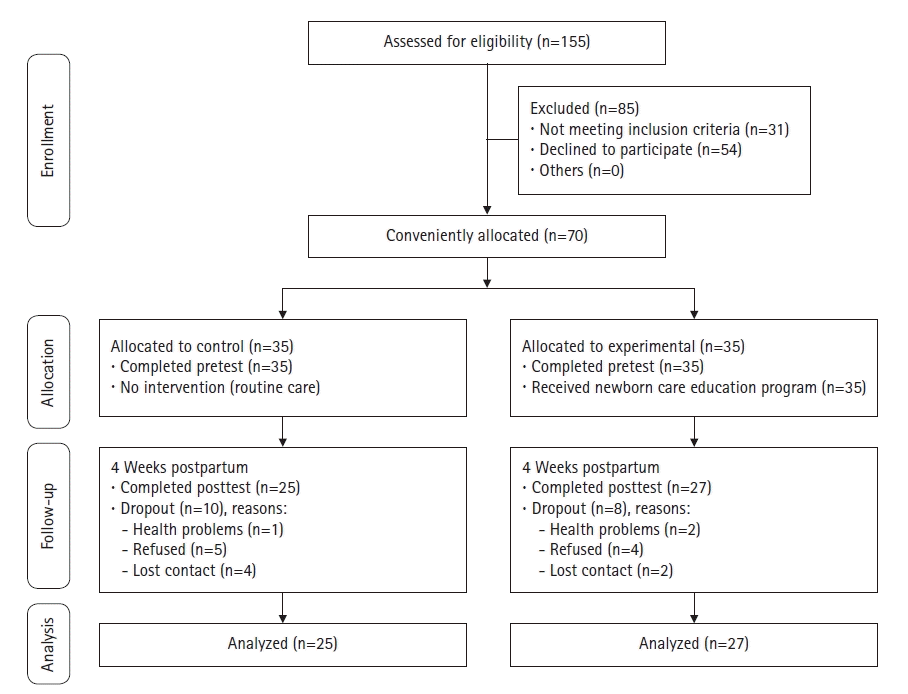2. World Health Organization. The importance of caregiver-child interactions for the survival and healthy development of young children: a review [Internet]. Geneva: Author;2004. [cited 2019 Jan 2]. Available from:
https://www.who.int/publications/i/item/924159134X.
3. Sujatha R. Cultural practices and beliefs on newborn care among mothers in a selected hospital of Mangalore Taluk. Nitte University J Health Sci. 2014; 4(2):21–26.
4. Newbrander W, Natiq K, Shahim S, Hamid N, Skena NB. Barriers to appropriate care for mothers and infants during the perinatal period in rural Afghanistan: a qualitative assessment. Glob Public Health. 2014; 9 Suppl 1(Suppl 1):S93–S109.
https://doi.org/10.1080/17441692.2013.827735.

5. Senarath U, Fernando DN, Vimpani G, Rodrigo I. Factors associated with maternal knowledge of newborn care among hospital-delivered mothers in Sri Lanka. Trans R Soc Trop Med Hyg. 2007; 101(8):823–830.
https://doi.org/10.1016/j.trstmh.2007.03.003.

7. Ceber E, Neriman SN, Karacasaydam B, Ektigenc R, Ozenturk G. The effects of mother and newborn home care education program on mother and persons providing care of mother/newborn. Balikesir Health Sci J. 2013; 2(1):22–28.
8. Amolo L, Irimu G, Njai D. Knowledge of postnatal mothers on essential newborn care practices at the Kenyatta National Hospital: a cross sectional study. Pan Afr Med J. 2017; 28:97.
https://doi.org/10.11604/pamj.2017.28.97.13785.

10. General Statistics Office and UNICEF. Viet Nam multiple indicator cluster survey 2014, final report. Ha Noi, Vietmam: Author;2014.
11. Shrestha S, Adachi K, Petrini MA, Shrestha S, Rana Khagi B. Development and evaluation of a newborn care education programme in primiparous mothers in Nepal. Midwifery. 2016; 42:21–28.
https://doi.org/10.1016/j.midw.2016.09.006.

12. Fu IC, Fong DY, Heys M, Lee IL, Sham A, Tarrant M. Professional breastfeeding support for first-time mothers: a multicentre cluster randomised controlled trial. BJOG. 2014; 121(13):1673–1683.
https://doi.org/10.1111/1471-0528.12884.

13. Ryu DA. Effect of newborn care education program on maternal role confidence and self esteem for unmarried mother [master’ thesis]. Daegu: Kyungpook National University;2014. 73.
14. Lee J, Oh S. Effects of the newborn parenting program for marriage immigrant primiparas on their parenting stress and mothers’ role confidence. Korean J Stress Res. 2016; 24(3):220–230.
https://doi.org/10.17547/kjsr.2016.24.3.220.

15. Sroiwatana S, Puapornpong P. Outcomes of video-assisted teaching for latching in postpartum women: a randomized controlled trial. Breastfeed Med. 2018; 13(5):366–370.
https://doi.org/10.1089/bfm.2018.0040.

16. Jones V, Jo JH. Ubiquitous learning environment: an adaptive teaching system using ubiquitous technology. In : In : Atkinson R, McBeath C, Jonas-Dwyer D, Phillips R, editors. Beyond the comfort zone: Proceedings of the 21st ASCILITE Conference; Perth. December 5-8, 2004; Perth: ASCILITE;2004. p. 468–474.
17. Des Jarlais DC, Lyles C, Crepaz N; TREND Group. Improving the reporting quality of nonrandomized evaluations of behavioral and public health interventions: the TREND statement. Am J Public Health. 2004; 94(3):361–366.
https://doi.org/10.2105/ajph.94.3.361.

18. Jang YS. Effects of a workbook program on the perceived stress level, maternal role confidence and breast feeding practice of mothers of premature infants. J Korean Acad Nurs. 2005; 35(2):419–427.
https://doi.org/10.4040/jkan.2005.35.2.419.

19. Parker S, Zahr L. The maternal confidence questionnaire. Boston, MA: Boston City Hospital;1985.
21. Bai Y, Middlestadt SE, Peng CY, Fly AD. Predictors of continuation of exclusive breastfeeding for the first six months of life. J Hum Lact. 2010; 26(1):26–34.
https://doi.org/10.1177/0890334409350168.

22. Goto A, Nguyen QV, Nguyen TT, Pham NM, Chung TM, Trinh HP, et al. Associations of psychosocial factors with maternal confidence among Japanese and Vietnamese mothers. J Child Fam Stud. 2010; 19(1):118–127.
https://doi.org/10.1007/s10826-009-9291-9.





 PDF
PDF Citation
Citation Print
Print




 XML Download
XML Download